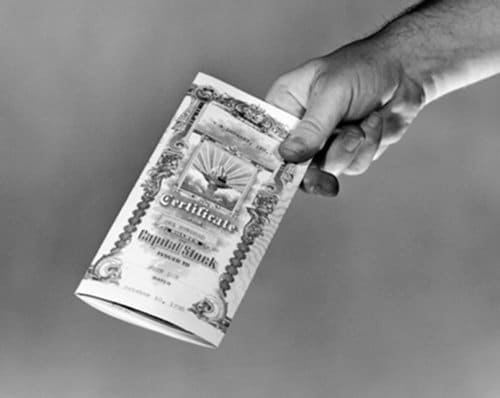
Editor’s note: This is a guest post from Matt Alden S., publisher of Dividend Monk.
The stock market can be a confusing and hectic place. Especially after witnessing recessions, bank-bailouts, and huge volatility, it can seem like it operates with no rhyme or reason.
A crucial skill for any man is the ability to master one’s own finances. It’s an important part of life to be able to understand exactly what he owns and why he owns it. But many men will admit they really don’t even know the basics of how the stock market works.
Fortunately, behind all of the noise of computer trading and non-stop financial media, the basics of buying and selling stock are pretty simple. Advances in technology and increases in the speed of news distribution may have complicated it on the surface, but the same general ideas hold as true today as they did 100 years ago. This article provides an overview of what stock is, and how shares of stock are bought and sold on the market.
A Share of Stock Is a Fraction of a Business
The ownership of a public company is collectively called “stock.” The shares of stock that are bought and sold between investors represent tiny fractions of that business.
For an example of a private company, if ten people hold equal portions of a small carpentry business, then the company can be thought of as consisting of ten shares, with each owner/investor holding one share. Since it’s divided ten ways between these shareholders, if the company earns a profit of $500,000 per year, the earnings per share will be $50,000.
The owners of the carpentry business could collectively decide to reinvest those profits into growing the company, or they could use some of the money to pay themselves part of the profits. If they want to leave the business, they could sell their share to someone else. One of the owners may even decide to buy a share from another owner, so that he now holds two shares, or 20% of the company.
A modern corporation works the same way, except that instead of ten shares, it consists of millions or even billions of shares. Corporations are “publicly traded,” meaning that there are “x” number of shares available and anyone can buy or sell them on an exchange. To organize that many owners into a leadership team, the shareholders vote for directors to lead the company. On an annual basis, the shareholders can vote to elect people to the Board of Directors, which is the highest operating authority in the organization. The Board then appoints the leadership team, including the Chief Executive Officer and other top management to run the day-to-day business operations.
The Board of Directors makes high level decisions on the direction of the business, and they also make the decision on whether to reinvest all profits back into the company for growth, or to pay out a portion of the total profit as cash payments, called dividends, to the shareholders.
Why Do Businesses Go Public?
Companies that go public generally do so because they want to collect more money for growth opportunities. If the owners of a privately held company want to have an easier time selling their private shares, or if they want to sell part of their company to the public to raise money for the business to grow faster, they hold an Initial Public Offering, referred to as an “IPO.” During an IPO, they will sell some of the shares of the company to the public, and from that point on, people can buy and sell those shares amongst themselves.
A smaller example can illustrate the basic process:
A man named John owns a business that sells premium mustache combs — the best in the world. He has ten employees, and he owns 100% of the company. For a while this works well, with him earning $100,000 per year in profit and his employees doing pretty well also. But it seems like every time Movember rolls around, it gets harder and harder to keep up with all the sales. After careful consideration, he decides to invite five fairly wealthy acquaintances to help grow his business.
They each chip in $50,000, and in exchange they each receive a 10% portion of the company. So John has raised $250,000 for his business, but now he only owns 50% of his company. The company can be considered to consist of ten shares worth $50,000 each, with John holding five of them and each of the five investors holding one of them. John can use this $250,000 to hire additional employees and buy more tools to grow the business at a quicker pace.
After five years, the profit of the business is up to $500,000 per year. Since John owns 50% of it, his portion of income is $250,000, and each of the investor’s portion of income is $50,000. They collectively decide, however, to keep reinvesting part of these profits back into the company to hire more employees and to buy more equipment.
After ten years, the company has grown even larger. It now has total annual profit of $2 million, and dozens of employees. But John is a particularly ambitious fellow, and he wants to spread his premium mustache combs throughout the world, and maybe even expand into other manly hygiene products.
So John and the five investors decide to “go public,” which means they will have an IPO and sell a portion of their company to public investors. John still owns 50% of the company and each of the five investors still owns 10%, but they decide that they’ll sell half of the company to the public in this IPO. This will bring in a lot of new money to fund their expansion.
John breaks the company into one million shares (meaning each one of the original ten shares was broken into 100,000 shares), and sells 500,000 of them to the public for $20 each. The rest of the shares are owned by John, who owns 250,000 shares (25% of the company), and the original five investors, who each own 50,000 shares (5% of the company each). John and the original investors diluted their ownership of the company (from 50% down to 25% for John, and from 10% down to 5% for each investor), but now, there is a lot more cash to work with.
By selling 500,000 shares to the public at $20 each, John raises $10 million for his men’s hygiene business to hire employees and purchase more tools in order to make all the mustaches of the world that much better. The initial five wealthy investors are happy too, because now they can easily sell their shares to anyone. They could sell their shares and retire, or they could buy more if they want to.
Now that John’s company is public, they have a lot more specific requirements to fulfill. They have to produce audited financial statements four times per year, they have to follow standards of sharing internal company information, and shareholders get to elect a Board of Directors to run the company.
Shares of Stock are Bought and Sold on a Stock Exchange
Since publicly traded companies consist of so many shares and are owned by so many people, it would be difficult to just buy and sell shares informally.
To solve this complexity, the buying and selling of stock takes place on a dedicated stock exchange. The largest exchange is the New York Stock Exchange on Wall Street, and there are other major ones such as the NASDAQ, the London Stock Exchange, and the Tokyo Stock Exchange. These exchanges are marketplaces (either physical or electronic) where the products that are bought and sold are shares of stock.
People can buy or sell shares of stock for a price they can agree on, and this price goes up and down over time based on the supply and demand of buyers and sellers. Over the short term, stock prices can be volatile because buyers and sellers have a whole multitude of reasons for trading stock at any given time.
Over the long term, the business performance of the underlying company determines the value of the stock. When John’s business was only making $100,000 in profit per year, a share worth 10% of the business only had a moderate amount of value. Later, when he grew the business to $500,000 in profit and eventually to $2 million in profit, a 10% portion of the company would be worth far more than it was back when the company was only making $100,000.
When the company was later split into a million shares, each share was less expensive because it only accounted for a tiny fraction of the company, but John and the original five investors each then owned thousands of shares due to the splitting of their original, larger shares. If John continues to skillfully manage what is now a publicly traded men’s hygiene products company, he could grow total profit to $5 million, $10 million, or even more. The price of the shares at any given time compared to the IPO price of $20 will fluctuate, but over the long term, if the business grows, the value of each share will grow. Each share in this case represents one millionth of a growing company.
For example, when the company has $2 million in profit and one million shares, John and the Board of Directors may decide to use 50% of that profit to pay $1.00 in cash dividends to each shareholder for each share they own. The shareholders may keep holding shares, and receive these dividends every time the company pays them. Years later, if the company is bringing in $5 million in profit per year, and they’re still paying out 50% of their profit as dividends to shareholders, then each shareholder will receive $2.50 in dividends per share that they own. There are some companies out there that have raised their dividends every year for over 25 or even 50 consecutive years.
On the other hand, if John’s business performs poorly over time, and the annual profit declines, then the shares of stock will eventually decline in value. If his company were to ever go bankrupt, then the price and value of shares would drop to $0.
How to Buy Shares of Stock
To buy a stake in publicly traded businesses, you have a few primary options. There is no best option; it depends on whether you want to pick individual stocks or not, how much money you have to invest, and what your goals are.
1) Use a Broker to Buy Shares of Stock
Rather than going to a stock exchange yourself, you can use a middleman to do the buying and selling for you. A broker is a person who is registered with the exchange and able to buy and sell shares of stock on it. In older times, you’d have to call up your broker or see him in person, but nowadays most interaction is done online. You can create an account online with a brokerage firm, and buy or sell stock within your account. It’s similar to online banking, and the shares that you hold will be held in this brokerage account.
For those that prefer seeing a broker face to face, there are full service brokerage firms that provide this option. They can provide personal investment advice and assist you with achieving your financial goals.
Either way, you’ll typically have to pay brokerage fees in order for them to buy and sell stock for you. Investors that often buy and sell stock can accumulate a lot of fees, but by investing for longer periods and buying less frequently, you can keep the cost low.
2) Participate in a Direct Stock Purchase Plan
Another low-fee or no-fee option is that you can buy stock directly from the company in a system called a Direct Stock Purchase Plan (DSPP). You can become a registered shareholder of the business directly through their transfer agent (the organization that manages and keeps track of their shares), and occasionally pay cash to buy more shares.
Certain types of Direct Stock Purchase Plans are called Dividend Reinvestment Plans (DRiPs). Under these plans, you own stock directly, and when the company pays cash dividends to shareholders, the company will automatically reinvest the cash dividends you would have received into buying more shares for you instead, including fractions of shares. Over long periods of time, you can grow a small number of inexpensive shares into a larger and larger number of more valuable shares, and exponentially increase your wealth and dividend income.
These plans are only for investors that intend to hold onto that company’s stock for quite a while. Unlike with a broker where you can easily buy and sell shares, these plans are meant for patient, long-term investors.
3) Invest in a Mutual Funds
If you don’t want to buy shares of individual companies, such as The Coca-Cola Company or General Electric, then mutual funds are another viable option.
A mutual fund is a collective investment vehicle where a pool of investors gather their money together and buy shares of many companies in one big fund. A fund manager is responsible for choosing which stocks to buy or sell within that investment vehicle. The assets that can be held within a mutual fund include stocks, bonds, cash, and other investments. Basically, rather than owning a specific stock, a mutual fund investor owns a piece of a bigger collection of a variety of stocks and/or other assets.
There are a vast number of different types of mutual funds, but they can be thought of as two general categories:
Actively Managed Mutual Funds. With an actively managed mutual fund, the fund manager is purposely selecting certain stocks to buy, hold, and eventually sell. Sometimes the fund manager’s goal is to try to provide a better rate of return for the investors than the average of other stocks, which means he’s attempting to “beat the market.” Other times, the fund manager may be trying to minimize volatility and preserve the wealth of the investors while still growing their money at a reasonable rate.
In order to pay for the buying and selling of shares within the fund, and in order to pay the fund manager, mutual funds typically have fairly high fees. The fees are a small portion of the fund value each year, but they can add up substantially over time.
Index Funds. An index fund is a passively managed mutual fund. The fund manager is not purposely choosing specific stocks to buy or sell in order to meet any goals. Instead, an index fund follows a specific list of many companies.
The most widely followed index list is the Standard and Poor’s 500, which is usually referred to as the S&P 500. This is a list of 500 of some of the largest and most profitable companies in the United States, and serves as a primary benchmark for long-term stock market performance.
The only goal of the fund manager of an S&P 500 index fund, is to try to replicate the performance of the list. He’ll buy shares of stock of those 500 companies in roughly the same proportions that the index recognizes. Because this process is rather automated, the fees for index fund investors are very low.
Buying into an index fund allows an investor to quickly become diversified, because holding a simple S&P 500 index fund spreads your money over approximately 500 companies.
The Relationship Between a 401(k), an IRA, and Shares of Stock
One potentially confusing aspect about the stock market is the overlap between 401(k) plans, IRAs, and shares of stock. Some people tend to mistake 401(k) plans and IRAs for investments, but they are simply retirement vehicles for holding investments. Typically within a 401(k) plan, you can choose to invest in a variety of mutual funds, including index funds. Within an IRA, you can invest in mutual funds, individual stocks, and other assets.
Conclusion
By working to build up some assets, either in the form of individual stock ownership, or through index funds and other investments, you can increase the financial flexibility that you have with regards to what you work on and how you live your life.
The stock market can be a damaging thing to people that are unfamiliar with the mechanics behind it, and money that you need to have available in a few years should not be used to buy stock now due to the volatile nature of the market over shorter periods. Instead, investing in the stock market is a long-term approach that requires discipline and balance.
Talking with a financial professional to get good advice, or seeking out information from a variety of sources, can provide a very rewarding outcome. The long term average rate of return of the S&P 500 over the last century or so has been around 9% per year. This means that, despite being volatile, an investor would have increased their wealth by 9% per year on average over a very long time frame. A rate of return of 9% per year translates into a doubling of your money every eight years.
_________________________
Matt Alden S. is the publisher of Dividend Monk, an investing and personal finance site that helps readers move closer towards financial freedom. The site includes comprehensive articles on dividend stocks, long-term investing, indexes, stock valuation techniques, and building wealth.







